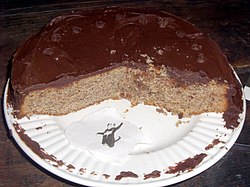 Hazelnut brown butter cake | |
| Main ingredients | Butter, sugar, flour, eggs |
|---|---|

A butter cake is a cake in which one of the main ingredients is butter. It is baked with basic ingredients: butter, sugar, eggs, flour and leavening agents such as baking powder or baking soda. It is considered one of the quintessential cakes in American baking. [1] Butter cake originated from the English pound cake, which traditionally used equal amounts of butter, flour, sugar, and eggs to bake a heavy, rich cake. [2]
